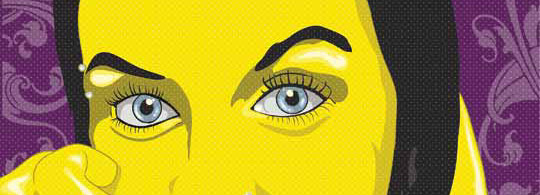This type of art has become very popular lately, invading most of the digital art sites and blogs. This is the reason why we try to make a relevant and documented post regarding this subject.
Etymologically the word vexel is a mix between the words vector and pixel, as Wikipedia explains. The word was introduced by Seth Woolley, then a collaborator of the Nova Boards website. The purpose of this type of art is to create raster images based on portrait-type pictures that are composed of vector-like smooth curbed lines made with the pen-tool.
At first sight, looking at this explanation we can see the difference between vector and vexel portraits, but once too many times we found that people use the two words inappropriately, calling a vector portrait vexel or confusing a vexel with vectors. Considering this aspect, we believe that a vexel, be it vector-made or raster, is actually creating a copy of a digital photography in which the number of color tones is visibly reduced, usually to 2-4 colors and 3-4 color tones of each color – that means a total number of 6-16 colors. The effect is achievable, in a rather clumsy manner with the LIVE TRACE option of some graphic programs, which automatically converts a raster image into a vector one, reducing the number of colors.
As an example, we chose the following picture and we applied the Live Trace filter on it.
Step by step Vexel Art
As you can see above, the result is far from impressive, but even so, we can get an idea on how Illustrator approaches the picture. Practically, we notice that for each color the program renders one to three resembling tones. Most artist do this tracing manually, in order to achieve an accurate and better controlled result. They start with a live trace in order to identify the areas where those tones meet and then they copy the resulted color swatch in order to keep the colors as close to the original ones as possible. After that, using the notorious pen tool they trace each area corresponding to a color tone. Doing that requires a huge amount of patience. An alternative is using a graphic tablet which may reduce with up to 50 percent the time needed for tracing such a project.
As you can see, using the same color tones as the original picture doesn’t guarantee a brilliant representation of the subject of choice. In this case, our model was rendered looking a little too masculine, which is not the intention of this project. That is why we recommend using pop-art tones, which are always fashionable and you will see that even if we take some steps away from photo realism, the result looks better. To bring your vector art to life, you can add to the final design by using a flourish background and a pixelated pattern imitating a canvas.

In the end, all you need is a partner that can print this on a canvas at 1440 dpi, a frame for the print and an empty wall on which to hang this piece of art for you and others to admire.






niceeeeee…love the colours!!
Looks awesome printed 🙂
Hi, bit confused, love the article but why print at 1440 dpi when the eye cant really see beyond the usual 300 dpi/ printers always ask for 300dpi, confused? what am i missing , thanks
Hi-Fi JET Pro II – FJ-540
The Hi-Fi JET Pro II offers the best digital print quality in the industry. Thanks to variable droplet technology, 1440×1440 dpi resolution and precise media movement, this wide format inkjet printer is ideal for producing fine art reproductions, photography and color proofs. It can also crank out graphics with blazing production speed.
We print at highest resolution
Hi there may I use some of the information here in this post if I provide a link back to your site?
Some brilliant ideas and very good and polished writing – your page goes straight to my bookmarks. I got some nice inspirational thoughts after reading it.
Hello Some good interesting content on here. Good work.
I was actually looking to purchase picture frames but stumbled upon your site and thoroughly liked it. Thanks
Hey, Good evening because i absolutely love your special site, i would be glad if you would like to me publish a blog review on your incredible work in my little would you grant me permission? Lenda Murray is my main interest.